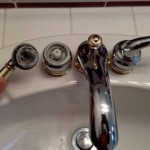Replacing a Bathroom Sink Faucet: A Comprehensive Guide
Replacing a bathroom sink faucet might appear daunting, but with the right tools, preparation, and knowledge, it can be a manageable DIY project. This article provides a detailed guide to help homeowners understand the process, ensuring a successful installation and avoiding potential plumbing mishaps. Proper planning and execution are crucial to achieving a professional-looking result and preventing water damage.
Before commencing any work, safety should be the primary concern. Turning off the water supply to the faucet is paramount. Ignoring this step can lead to significant water leakage and potential flooding. Gathering all necessary tools and materials beforehand will streamline the process and prevent interruptions. Finally, understanding the different types of faucets available and selecting the appropriate replacement is essential for both functionality and aesthetics.
Key Point 1: Preparation and Gathering Supplies
The initial phase involves meticulous preparation. Start by identifying the type of faucet currently installed. Common types include center-set faucets (typically used for sinks with three holes, spaced 4 inches apart), widespread faucets (suitable for sinks with three holes, spaced 6-12 inches apart), and single-handle faucets (designed for sinks with one or three holes). Knowing the existing faucet type will help determine the appropriate replacement and any necessary adapters or accessories.
Next, gather all the required tools and materials. A basin wrench is essential for loosening and tightening connections in tight spaces under the sink. Adjustable pliers, a screwdriver (both Phillips and flathead), a putty knife or scraper, plumber's putty or silicone sealant, and a new faucet are all necessary. A flashlight or work light will improve visibility in the often-dark under-sink area. Also, have a bucket and towels handy to catch any residual water. Safety glasses and gloves are recommended for protection.
Once all the tools and materials are assembled, the next step is to shut off the water supply. Locate the shut-off valves under the sink, typically one for hot water and one for cold water. Turn both valves clockwise until they are completely closed. After closing the valves, turn on the existing faucet to relieve any remaining pressure in the pipes. If the shut-off valves are corroded or do not function properly, it might be necessary to shut off the main water supply to the house. This should be done with caution and only if the under-sink valves are truly unusable.
Finally, protect the surrounding area. Place a drop cloth or old towels around the sink and cabinet to prevent scratches or damage from dropped tools or water spills. Clear any clutter from under the sink to create a comfortable and safe workspace.
Key Point 2: Removing the Old Faucet
With the preparation complete, the next phase involves removing the existing faucet. Begin by disconnecting the water supply lines from the faucet's tailpieces. Use a basin wrench or adjustable pliers to loosen the connections. Be prepared for some residual water to spill out, even after relieving the pressure. Have a bucket and towels readily available to catch any drips.
Once the water lines are disconnected, locate the mounting hardware that secures the faucet to the sink. This hardware typically consists of nuts, washers, and mounting plates. Use a basin wrench or screwdriver to loosen and remove these components. Accessing this hardware can be challenging due to the limited space under the sink. Patience and persistence are often required.
After removing the mounting hardware, the old faucet should be free to lift out of the sink. Gently wiggle the faucet to loosen any remaining sealant or corrosion. If the faucet is stuck, use a putty knife or scraper to carefully break the seal between the faucet base and the sink. Be cautious not to scratch or damage the sink surface.
Once the old faucet is removed, thoroughly clean the sink surface. Use a putty knife or scraper to remove any old plumber's putty or silicone sealant. Clean the area with a household cleaner to remove any dirt, grime, or mineral deposits. A clean surface is essential for a proper seal with the new faucet.
Inspect the sink drain assembly while the faucet is removed. If the drain is old, corroded, or leaking, consider replacing it at the same time. This is an opportune time to address any issues with the drain, as it is much easier to access with the faucet removed.
Key Point 3: Installing the New Faucet
Before installing the new faucet, carefully read the manufacturer's instructions. Each faucet model may have specific installation requirements. Familiarize yourself with the components and the recommended installation procedure. This will help avoid errors and ensure a proper installation.
Apply a bead of plumber's putty or silicone sealant around the base of the new faucet. This will create a watertight seal between the faucet and the sink. Follow the manufacturer's instructions regarding the type and amount of sealant to use. Ensure the sealant is evenly distributed and covers all contact surfaces.
Carefully insert the new faucet into the sink holes. Align the faucet with the sink and ensure it is properly positioned. From underneath the sink, attach the mounting hardware according to the manufacturer's instructions. This typically involves installing washers, mounting plates, and nuts. Tighten the nuts securely, but avoid over-tightening, which can damage the sink or the faucet. Use a basin wrench to access hard-to-reach nuts.
Connect the water supply lines to the faucet's tailpieces. Use Teflon tape on the threads of the tailpieces to ensure a watertight seal. Tighten the connections securely with adjustable pliers or a wrench, but avoid over-tightening. Ensure the water supply lines are properly aligned and not kinked or twisted.
After connecting the water supply lines, slowly turn on the shut-off valves under the sink. Check for any leaks around the faucet base, the water supply line connections, and the drain assembly. If any leaks are detected, immediately turn off the water supply and tighten the connections. Reapply sealant if necessary.
Once all leaks are resolved, test the faucet thoroughly. Turn the faucet on and off, and check both hot and cold water flow. Ensure the water temperature is correct and that the faucet operates smoothly. Inspect the drain for proper drainage and check for any leaks. If any issues are identified, troubleshoot the problem and make any necessary adjustments.
Finally, clean up the area around the sink. Remove any tools, materials, and debris. Wipe down the sink and countertop to remove any water spots or fingerprints. Dispose of the old faucet and any used materials properly. A clean and organized workspace is the final touch of a successful installation.
Replacing a bathroom sink faucet requires careful planning, preparation, and execution. By following these steps and paying attention to detail, homeowners can successfully complete this project and enjoy a new and functional faucet. Remember to prioritize safety and consult with a professional plumber if you encounter any difficulties or have any concerns.

How To Replace A Bathroom Faucet Moen Single Handle Install

Replacing A Bathroom Faucet Fine Homebuilding

Diy How To Replace A Bathroom Sink Faucet Remove Install

How To Replace A Bathroom Faucet Home Repair Tutor

How To Replace Your Bathroom Faucet Plumbcraft Series With Penny

How To Replace A Bathroom Faucet Removal And Installation

How To Replace A Bathroom Faucet Tinged Blue

How To Replace A Bathroom Faucet Removal And Installation

How To Remove And Install A Bathroom Faucet

How To Replace A Bathroom Faucet Removal And Installation
Related Posts







